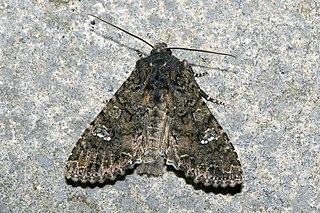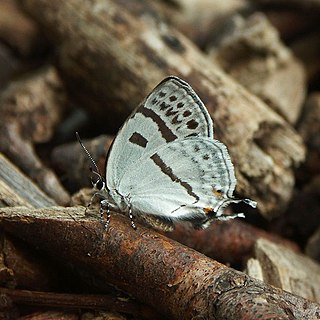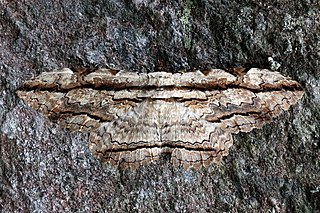
The common blue butterfly or European common blue is a butterfly in the family Lycaenidae and subfamily Polyommatinae. The butterfly is found throughout the Palearctic and has been introduced to North America. Butterflies in the Polyommatinae are collectively called blues, from the coloring of the wings. Common blue males usually have wings that are blue above with a black-brown border and a white fringe. The females are usually brown above with a blue dusting and orange spots.

The scalloped hazel is a moth of the family Geometridae. The species was first described by Carl Alexander Clerck in 1759.

The willow beauty is a moth of the family Geometridae. It is a common species of Europe and adjacent regions. While it is found widely throughout Scandinavian countries, which have a maritime climate, it is absent from parts of the former USSR which are at the same latitude but have a more continental climate.

Eurytides marcellus, the zebra swallowtail, is a swallowtail butterfly native to the eastern United States and south-eastern Canada. It is the state butterfly of Tennessee. Its distinctive wing shape and long tails make it easy to identify, and its black-and-white-striped pattern is reminiscent of a zebra. The butterflies are closely associated with pawpaws, and are rarely found far from these trees. The green or black caterpillars feed on the leaves of various pawpaw species, while the adults feed on flower nectar and minerals from damp soil.

The cabbage moth is primarily known as a pest that is responsible for severe crop damage of a wide variety of plant species. The common name, cabbage moth, is a misnomer as the species feeds on many fruits, vegetables, and crops in the genus Brassica. Other notable host plants include tobacco, sunflower, and tomato, making this pest species particularly economically damaging.

Tirumala limniace, the blue tiger, is a species of butterfly found in South Asia, and Southeast Asia that belongs to the brush-footed butterfly family, Nymphalidae. More specifically it is part of the crows and tigers or danaid group. This butterfly shows gregarious migratory behaviour in southern India. In some places, it may be found in congregations with Danaus genutia, Tirumala septentrionis, Euploea sylvester, Euploea core, Parantica aglea, and at high elevations, with Parantica nilgiriensis, on Crotalaria.

Battus philenor, the pipevine swallowtail or blue swallowtail, is a swallowtail butterfly found in North America and Central America. This butterfly is black with iridescent-blue hindwings. They are found in many different habitats, but are most commonly found in forests. Caterpillars are often black or red, and feed on compatible plants of the genus Aristolochia. They are known for sequestering acids from the plants they feed on in order to defend themselves from predators by being poisonous when consumed. The adults feed on the nectar of a variety of flowers. Some species of Aristolochia are toxic to the larvae, typically tropical varieties. While enthusiasts have led citizen efforts to conserve pipevine swallowtails in their neighborhoods on the West coast, the butterfly has not been the subject of a formal program in conservation or protected in legislation. The butterfly is however of "Special Concern" in Michigan, which is on the Northern limit of its range.

Lampides boeticus, the pea blue, or long-tailed blue, is a small butterfly that belongs to the lycaenids or gossamer-winged family.

Papilio aegeus, the orchard swallowtail butterfly or large citrus butterfly is a species of butterfly from the family Papilionidae, that is found in eastern Australia and Papua New Guinea.

The black arches or nun moth is a small Palaearctic moth. It is considered a forest pest.

Brahmaea (Acanthobrahmaea) europaea, the European owl moth, is a lepidopteran from the family Brahmaeidae, in the subgenus Acanthobrahmaea.

The scarce fritillary is a species of butterfly in the family Nymphalidae. It is found in Austria, Bulgaria, Czech Republic, Finland, France, Germany, Greece, Hungary, Kazakhstan, Lithuania, Luxembourg, Poland, Romania, Russia, Serbia and Montenegro, and Sweden. and East across the Palearctic to Mongolia.

Palpita vitrealis, common name jasmine moth or white pearl, is a species of moth of the family Crambidae.

Utetheisa pulchella, the crimson-speckled flunkey, crimson-speckled footman, or crimson-speckled moth, is a moth of the family Erebidae. The species was first described by Carl Linnaeus in his 1758 10th edition of Systema Naturae.

Antigius attilia is a butterfly of the family Lycaenidae. It is widespread from Japan, the Korean Peninsula, the Russian Far East throughout northern, central and western China to Taiwan.

Ligustrum robustum grows as a shrub or small tree up to 10 m (30 ft) tall though old specimens of more than a hundred years have been observed with a height of 15 m (50 ft). The fruit of the shrub is an ellipsoid berry, bluish-purple when fully ripe, 7–10 mm (0.28–0.39 in) × 4–5 mm (0.16–0.20 in).

Psilogramma casuarinae, the Australasian privet hawk moth, is a moth of the family Sphingidae. The species was first described by Francis Walker in 1856. It is known from New South Wales, the Northern Territory and Queensland, all in Australia.

Brahmaea japonica, the Japanese owl moth, is a species of moth of the Brahmaeidae family native to Japan.

Synanthedon formicaeformis, the red-tipped clearwing, is a moth of the family Sesiidae and can be found in all of Europe, the eastern Palearctic realm, and the Near East. The larvae sometimes form pear-shaped galls on willows. It was first described by Eugenius Johann Christoph Esper in 1783.

Thysania zenobia, the owl moth, is a species of moth in the family Erebidae. The species was first described by Pieter Cramer in 1776, and is native to North and South America and the Caribbean.





















